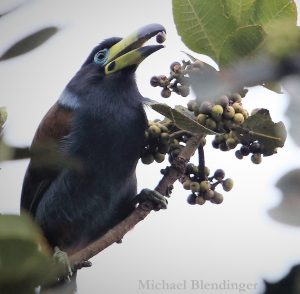
The decision of which fruits to eat depends on the geographic location of bird populations, such as this Hooded Mountain-Toucan (Photo: Michael Blendinger). This information is relevant in the current scenario of global climate change, which drive many populations to live near or outside their former distribution limits.
Natural selection can lead species to select a diet that optimizes their energy intake. However, local contexts, such as environmental stress, could accentuate the pressure to optimize diet. This can result in geographic changes in the matching of traits between consumers and resources, for example, between the size of a frugivore's beak and the size of the fruits it consumes. To test this idea, an international team of researchers, including Pedro Blendinger from the Instituto de Ecología Regional, assembled a large-scale dataset of fruit consumption by 97 bird species recorded at 126 study sites across six continents.
The study focused on how birds select the fruits they consume, especially at the margins of their geographic ranges. The margins of a geographic range are the areas furthest from a species’ center of distribution, where environmental conditions are typically more extreme and less favorable. The results show that birds whose diet is more dependent on fruits tend to choose those that most closely match their beak size when they are at these margins. This behaviour is not observed in birds that have more varied diets or are less dependent on fruits, which can supplement their diet with other types of food.
The rationale behind this selection is that, under more stressful conditions such as those found at geographic margins, it is crucial for survival to maximize the efficiency of food intake. By choosing fruits that better fit their beak size, these birds could consume them more easily, becoming more efficient at obtaining energy from each fruit. This process is not only vital for the birds' survival under stressful conditions; it also has important implications for seed dispersal. Plants whose seeds are consumed have a greater chance of being dispersed into new areas, which can influence the structure and dynamics of ecosystems.
The study's findings support the hypothesis that higher energetic costs near the geographic distribution limits of species force frugivorous birds to optimize their diet by consuming the most profitable fruits, namely those that most closely fit their beak size. These findings are important in the current context of climate change, as global changes are expected to cause shifts and contractions in species' ranges, forcing many populations to live near or outside their historical distribution limits.
